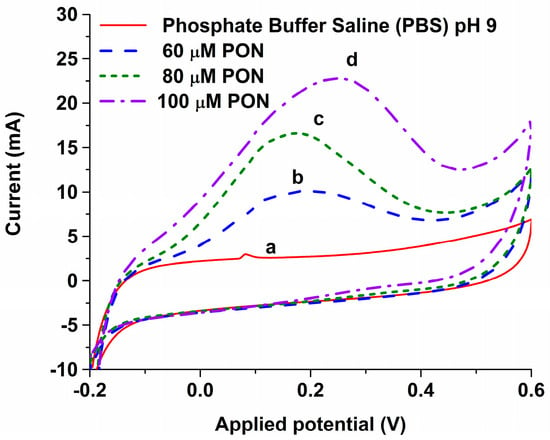Abstract
As biostimulants may have a mechanism related to increasing tolerance to abiotic stress (drought, salinity, heat shock, etc., which will increase the production of Reactive Oxygen Species, ROS, such as peroxynitrite (PON)), this work proposes electrochemical solutions for the rapid screening of biostimulants, based on a sensor’s selectivity toward PON, for further efficient biostimulant formulation, as nowadays, biostimulants are still developed and commercialized using compositions developed by hazard, and not by design (as this work proposes).
1. Introduction
Peroxynitrite (PON) is one of the most powerful anionic oxidants, which is associated with diseases such as Alzheimer’s, arthrosis, cancer, etc. and also has a strong influence on plant growth. Selective, rapid, sensitive and direct methods for the detection of peroxynitrite are still scarce. As PON is a Reactive Oxygen Species (ROS), it modulates the growth and development of plants, as it acts as an endo-signaling molecule, especially in abiotic stress situation [1].
2. Materials and Methods
The present work refers to the processes of preparing different peroxynitrite electrosensitive depositions via electro-polymerization and/or drop-casting, using metal phthalocyanines/tetra-amino phthalocyanines (with different transitional metals coordinated to pyrrole groups, metals such as Mn, Co, Zn and Fe, or without metals), as well as methods for selective determination, using these peroxynitrite electrosensitive depositions.
3. Results
The developed selective peroxynitrite determination methods consist of different electrochemical techniques using the following steps: stabilization of the probe at pH 9, inserting the electrodeposited/drop-casted sensors into the analyzed probe (which may also include interfering species in addition to peroxynitrite) and the quantification of peroxynitrite using calibration curves, depending on the nature and concentrations of the peroxynitrite (Figure 1). The electrodes were characterized using Scanning Electron Microscopy (SEM), Raman spectroscopy, X-Ray Fluorescence (XRF), as well as using different electrochemical techniques (such as Cyclic Voltammetry, CV and Chronoamperometry, CA).

Figure 1.
Cyclic voltammograms (CV) for the selective method of peroxynitrite (PON) determination, using electro-polymerized cobalt tetra-amino phthalocyanine screen-printed carbon electrodes (polyCoTAPc/SPCE), in the potential window −0.2 to 0.6 V, with a scan rate of 16 mV/s, at different peroxynitrite concentrations: (a) 0 µM, (b) 60 µM, (c) 80 µM, (d) 100 µM, in Phosphate Buffer Saline (PBS) pH 9.
4. Conclusions
The presented processes are efficient for peroxynitrite detection and the best ones will be further used for screening biostimulants, as well for comparing the results with those obtained using the confirmation method (bioassay method based on fluorescent dyes) and the validation method (applying the best biostimulants for growing plants).
5. Patents
Ioana Silvia Hosu, Processes for preparing peroxynitrite electrosensitive depositions and methods of selective detection, Patent Application Number A00445/2023 [2].
Author Contributions
Conceptualization, I.S.H.; methodology, I.S.H.; formal analysis, I.S.H.; investigation, I.S.H., A.M.B., R.I.M. and T.F.; writing—original draft preparation, I.S.H.; writing—review and editing, I.S.H., A.M.B., R.I.M. and T.F.; supervision, I.S.H.; project administration, I.S.H. All authors have read and agreed to the published version of the manuscript.
Funding
This work was supported by a grant from the Ministry of Research, Innovation and Digitization, CNCS-UEFISCDI, project number PN-III-P1-1.1-PD-2021-0798, within PNCDI III, contract number PD116/2022.
Institutional Review Board Statement
Not applicable.
Informed Consent Statement
Not applicable.
Data Availability Statement
The supporting data are available from the corresponding author.
Conflicts of Interest
The authors declare no conflict of interest.
References
- Nephali, L.; Piater, L.A.; Dubery, I.A.; Patterson, V.; Huyser, J.; Burgess, K.; Tugizimana, F. Biostimulants for Plant Growth and Mitigation of Abiotic Stresses: A Metabolomics Perspective. Metabolites 2020, 10, 505. [Google Scholar] [CrossRef] [PubMed]
- Hosu, I.S. Processes for preparing peroxynitrite electrosensitive depositions and methods of selective detection. OSIM, A00445/2023, 8 October 2023.
Disclaimer/Publisher’s Note: The statements, opinions and data contained in all publications are solely those of the individual author(s) and contributor(s) and not of MDPI and/or the editor(s). MDPI and/or the editor(s) disclaim responsibility for any injury to people or property resulting from any ideas, methods, instructions or products referred to in the content. |
© 2023 by the authors. Licensee MDPI, Basel, Switzerland. This article is an open access article distributed under the terms and conditions of the Creative Commons Attribution (CC BY) license (https://creativecommons.org/licenses/by/4.0/).